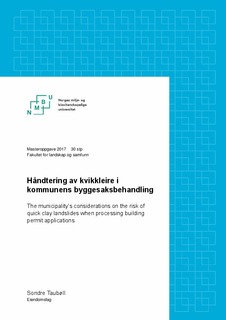| dc.description.abstract | Denne oppgaven tar for seg hvordan kommunen skal håndtere risiko for kvikkleireskred i sin byggesaksbehandling.
Kvikkleire kan få dramatiske konsekvenser for samfunnet dersom den ikke behandles riktig. En stor andel av Norges kommuner er berørt av utfordringer knyttet til kvikkleire. Ikke minst har en rekke byer fått problemer med videre byutvikling som følge fersk kartlegging. Det juridiske ansvaret kommunen har for sikkerhet mot skred strekker seg langt, og forhold som manglende teknisk og juridisk kompetanse, begrensede ressurser og tidspress kan medføre at det blir tatt avgjørelser der at kommunen ikke har overholdt lovens krav til forsvarlig vurdering. Dette kan for det første føre til store materielle skader og tap av menneskeliv, og for det andre erstatningsansvar for kommunen. Plan- og bygningsloven § 28-1 stiller krav om at områder bare kan bebygges dersom det foreligger «tilstrekkelig sikkerhet» mot fare, men i forbindelse med sikkerhetskravet reiser det seg en rekke problemstillinger knyttet til ansvarsforhold mellom kommune og tiltakshaver. I tillegg stiller skadeserstatningsloven § 2-1 krav til at byggesaksbehandlingen skal utføres på aktsomt vis. Det sentrale siktemålet med masteroppgaven er derfor å kartlegge de juridiske krav som stilles til saksbehandlingen, og videre holde disse kravene opp mot partenes muligheter til å forstå risikobildet.
Oppgaven innledes med en beskrivelse av kvikkleire i et naturfareperspektiv. Videre beskrives sentrale aktører som er involvert i byggesaker der kvikkleirerisiko må utredes. Oppgavens fjerde kapittel består av en klarlegging av gjeldende rett, der det blir redegjort for kravene som stilles til sikkerhet, aktsomhet og informasjonsgrunnlag. I påfølgende kapittel fokuseres det på forholdet mellom gjeldende rett og avhandlingens underproblemstillinger, som spesielt problematiserer hvilke prosedyrer som burde benyttes for å tilfredsstille lovens krav.
---
This thesis is evaluating the municipality’s considerations on the risk of quick clay landslides when processing building permit applications.
Quick clay has the potential to cause dramatic consequences if it is not handled correctly. A high number of municipalities in Norway are affected by the challenges quick clay opposes. In addition, multiple cities have faced problems with further city development, as a consequence of new danger zone mapping. The municipality’s legal responsibilities regarding landslides covers multiple aspects, and circumstances such as lack of technical and legal competence, limited resources and lack of time can cause decisions being made where the municipality have not obliged to the law for a proper assessment of natural hazards. This may lead to huge material destructions, loss of human life and claims against the municipality for compensation of damages. The Norwegian Planning and Building Act § 28-1 demands that areas can only be built upon when the area is not “sufficient safe” against hazards. However, the safety demands and the responsibility allocation between the municipality and the developer raise multiple problems to be addressed. In addition, the Damages Act § 2-1 states that an employer, including the municipality, is liable for damage caused negligently by employees. When it comes to security against natural hazards, including landslides, the efforts of the municipality are assessed by an ordinary culpa standard. The overall aim of the thesis is to establish the legal requirements regarding the processing of applications, and furthermore, evaluate these requirements in regards to the parties’ possibilities to understand the risks involved.
The thesis starts with a description of quick clay in a nature hazard perspective. Furthermore follows a description of the central parties involved in building applications where quick clay risks have to be investigated. The fourth chapter of the thesis consists of a clarification of the legal matter, which describes the requirements regarding safety, precautions and basis of information. The following chapter focuses on the relation between the law and the other sub problems discussed in the thesis, especially which procedures should be utilized to satisfy the requirements of the law. | nb_NO |

